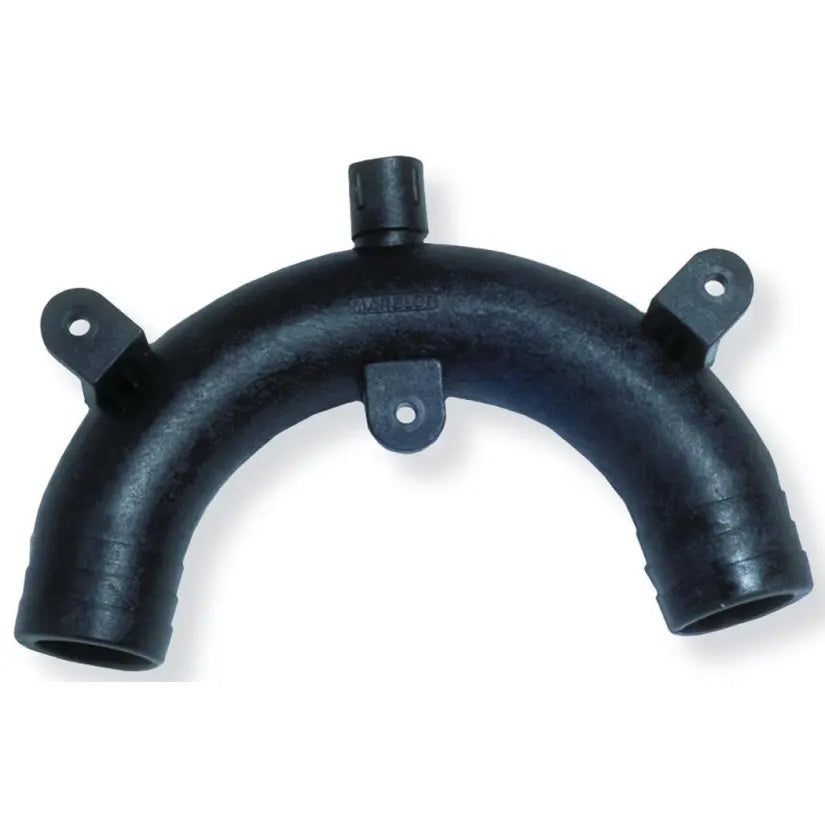One of the most unfortunate—and completely avoidable—accidents in sailing is flooding your engine. It’s a surprisingly high risk when your engine is installed below the waterline. In rough seas, or when the boat is being towed, water can siphon back into the exhaust system and make its way into your engine. The results? Catastrophic.
To avoid this, every well-thought-out raw water system should include a siphon break, also known as a vented loop. Even if you haven’t had issues yet, that doesn’t mean your system is safe under all conditions.
⚖️ ABYC Standard 1.7.2.2
The waterlift system shall be designed to prevent siphoning through the raw water pump when the engine is stopped.

🚩 Who’s at Risk?
A vented loop is essential for:
- Sailboats under sail with the engine shut off
Especially in rough seas, large waves can create conditions for siphoning.
💡 Tip: In rough seas, close your seacock. Just don’t forget to open it before restarting the engine!
- Boats being towed
Especially in rough seas, large waves can create conditions for siphoning.
💡 Tip: Close the seacock while being towed.
- Twin-engine boats backing down
Reverse thrust may force water up the system if unprotected.
- Boats with forward-facing scoop-type water inlets
If the scoop faces forward, it can create positive pressure in the raw water system.
💡 Tip: On sailboats or generators, face the scoop aft to prevent pressure buildup.
- Cranking the engine too long without a start
If the engine doesn’t start, water can build up in the exhaust hose and backflow into the engine.
💡 Tip: If extended cranking is needed, close the seacock during the process. Do not forget to open the seacock once the engine starts.
🔧 How to Install a Vented Loop

Source: ABYC. P-1 - Installation of Exhaust Systems for Propulsion and Auxiliary Engines.
Proper installation is critical to function:
1. Install above the waterline
- Position the loop 12 to 18 inches (30–45 cm) above the waterline at rest.
- Add extra height if it’s off-centerline or the boat heels significantly.
⚖️ ABYC Standard 1.7.2.2.1
If this is accomplished through the use of a siphon break device, it shall be installed per the component manufacturer's requirements or at a minimum located at the top of a loop. For proper operation the siphon break device shall be installed sufficiently above the water level surrounding the boat. The loop shall be between the water pump outlet and the point of injection of cooling water into the exhaust system.
NOTES:
-
- For auxiliary power in sailboats, it is best to locate the siphon break on the boat's centerline. If it cannot be on the centerline, additional height is required to keep the break above the waterline at the maximum expected heel and pitch.
- Depending on the design of the boat, the condition of its loading, and the sea conditions encountered, this loop may be 12 to 18 in (30 to 45 cm) above the waterline at repose.
2. Install between the raw water pump outlet and the exhaust injection point
3. Mount on the centerline, if possible
- This keeps the loop above water even when the boat heels.
🔄 Vented Loop Maintenance
Don’t “install and forget.” These devices need regular checkups:
- 🔍 Inspect annually
- 🧼 Check for salt build-up, debris, or corrosion
- ⚙️ Make sure the valve isn’t clogged or stuck
To clean the duckbill, soak it in white vinegar for a few hours to dissolve salt and calcium deposits. When reassembling, remember not to over-tighten the cap.
⚖️ ABYC Standard 1.7.2.2.1
Some siphon break devices require periodic maintenance to maintain their intended effectiveness. One problem encountered is the formation of salts or the products of corrosion that prevent the device from operating.
A blocked vented loop is just as dangerous as not having one at all.
✅ Final Thoughts
Installing a vented loop is a small job with huge protective benefits. It’s a key piece of a smart, seaworthy setup—especially on boats where the engine sits below the waterline.
If you don’t already have one, add it to your list. If you do, inspect it regularly. When the seas turn rough or something unexpected happens, your engine (and your wallet) will thank you.

